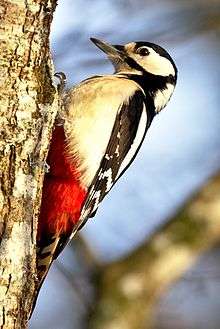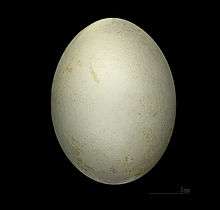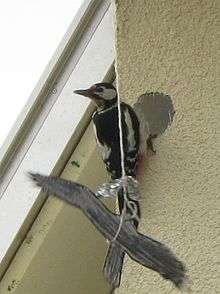Great spotted woodpecker
| Great spotted woodpecker | |
|---|---|
| | |
| Bird recorded in Devon, England | |
| Scientific classification | |
| Kingdom: | Animalia |
| Phylum: | Chordata |
| Class: | Aves |
| Subclass: | Neornithes |
| Infraclass: | Neognathae |
| Superorder: | Neoaves |
| Order: | Piciformes |
| Family: | Picidae |
| Subfamily: | Picinae |
| Tribe: | Dendropicini |
| Genus: | Dendrocopos |
| Species: | D. major |
| Binomial name | |
| Dendrocopos major (Linnaeus, 1758) | |
 | |
| Synonyms | |
|
Dendrocopos submajor | |
The great spotted woodpecker (Dendrocopos major) is a bird species of the woodpecker family (Picidae). The genus name Dendrocopus is a combination of the Greek words dendron , meaning "tree" and kopos, "striking ". The specific major is from Latin maior, "greater".[2]
It is distributed throughout Europe and northern Asia, and usually resident year-round except in the colder parts of its range. It is not considered a threatened species by the IUCN, being widely distributed and quite common. A significant recent increase in the British population has resulted in the recolonisation of Ireland.
Description
The great spotted woodpecker is 23–26 centimetres (9.1–10.2 in) long, with a 38–44 centimetres (15–17 in) wingspan. Weight: 70–98 g.[3] The upperparts are glossy black, with white on the sides of the face and neck. A black line zigzags from the shoulder halfway across the breast (in some subspecies nearly meeting in the centre), then back to the nape; a black stripe, extending from the bill, runs below the eye to meet this latter part of the zigzag line. On the shoulder is a large white patch and the flight feathers are barred with black and white. The three outer tail feathers are barred; these show when the short stiff tail is outspread, acting as a support in climbing. The underparts are dull white, the abdomen and undertail coverts crimson. The bill is slate black and the legs greenish grey.
Males have a crimson spot on the nape, which is absent in females and juvenile birds. In the latter, the top of the head is crimson between the bill and the center of the crown instead.
 |
A great spotted woodpecker drumming
|
| Problems playing this file? See media help. | |
Despite its contrasting plumage, the great spotted woodpecker is often an inconspicuous bird. The large white shoulder patch is the feature that most easily catches the eye. When hidden by the foliage, its presence is often advertised by the mechanical drumming, a vibrating rattle, produced by the rapidly repeated blows of its strong bill upon a trunk or branch. The drumming of this species is shorter than that of the lesser spotted woodpecker, and fades away at the end. It is audible from a great distance, depending on the wind and the condition of the wood, a hollow bough naturally producing a louder note than living wood. The call is a sharp kik, kik.
The great spotted woodpecker has several living subspecies. The paleosubspecies D. m. submajor lived during the Middle Pleistocene Riss glaciation (250,000 to 300,000 years ago); it was found in Europe south of the ice sheet. It is sometimes treated as a distinct species, but did not differ from the living great spotted woodpecker of Europe except in size; the European subspecies of our time are probably its direct descendants.[4][5]
Similar species
The male great spotted woodpecker is almost unmistakable. The only species that are quite similar are the Syrian woodpecker (D. syriacus) and the white-winged woodpecker (D. leucopterus). The former differs in the less well-developed zigzag stripe on the neck, which neither reaches as far towards the centre of the breast nor meets the black of the nape as it does in great spotted woodpeckers. The latter has a far more extensive white wing patch.
Females can be distinguished from female Syrian woodpeckers and white-winged woodpeckers in the same way as males; the female Sind woodpecker (D. assimilis) also looks similar but does not have the zigzag stripe reaching the nape. Great spotted woodpecker females can also be confused with a female white-backed woodpecker (D. leucotos). However, the latter species lacks the white shoulder patch, having an all-white lower back instead; it also has a less well-developed zigzag stripe on the neck, just like the Syrian woodpecker. The female Himalayan woodpecker (D. himalayensis) is also similar, but it can be distinguished by the same characteristics as the female Syrian woodpecker.
Immature birds resemble the middle spotted woodpecker (D. medius), the male white-backed woodpecker, the immature Syrian and white-winged woodpeckers, and male or immature lesser spotted woodpeckers (Picoides minor, formerly also in Dendrocopos). The first of these species has only an angular cheek spot instead of the zigzag stripe, while the white-backed and lesser spotted woodpeckers lack the white shoulder patch and have a less well-developed zigzag stripe, as described above. The lesser spotted woodpecker also has no red on the abdomen. White-backed woodpeckers are also larger, while lesser spotted woodpeckers are smaller than immature great spotted woodpeckers. Differences from Syrian and white-winged woodpeckers are the same as for adults.
The species has recently recolonized Ireland, where it apparently became extinct in the seventeenth century;[6] in 2011 there were an estimated 50 breeding pairs, concentrated mainly in Wicklow and Down.
 Female Syrian woodpecker
Female Syrian woodpecker Female white-backed woodpecker
Female white-backed woodpecker_cut.jpg) Middle spotted woodpecker (sexes are alike)
Middle spotted woodpecker (sexes are alike)
Ecology
.jpg)

It is an inhabitant of woodlands and parks, depending for food and nesting sites upon old trees. Its actions are jerky, and it hops rather than climbs, leaping forward with one foot just in advance of the other. When a space is crossed the flight is easy and undulating.
The food mainly consists of insects and grubs but also seeds, fruit, scraps, eggs, chicks and small rodents. The woodpecker usually alights on the trunk, working upwards, from side to side, but sometimes will perch in passerine style, when it sits well upright. During the ascent it taps the bark, breaking off fragments, but often extracts its prey from crevices with the tip of its sticky tongue. Beechmast, acorns, nuts and berries are eaten when animal food is scarce.
The nesting hole, neat and round, is bored in soft or decaying wood horizontally for a few inches, then perpendicularly down. At the bottom of a shaft, usually from six to twelve inches in depth, a small chamber is excavated and lined with wood chips. This woodpecker shows no marked preference for particular tree taxa, building its nest in gymnosperms and angiosperms alike.
In Japanese forests for example, nests were observed in Fagales (Grey Alder, Alnus hirsuta ssp. incana; Japanese White Birch, Betula platyphylla; Japanese Hop-hornbeam, Ostrya japonica), Lamiales (Japanese Tree Lilac, Syringa reticulata), Malvales (Japanese Lime, Tilia japonica), Malpighiales (willows, Salix sp.), Pinales (Japanese Larch, Larix kaempferi), Rosales (Sargent's Cherry, Prunus sargentii) and Sapindales (Usugumo Maple, Acer pictum subsp. mono– Painted Maple). Mongolian Oak (Quercus mongolica, Fagales) and Prickly Castor-oil Tree (Kalopanax pictus, Apiales) were rarely if ever used for nesting however.[7]
Nesting trees chosen by this woodpecker almost invariably have soft heartwood and tough sapwood, often due to parasites or diseases that weaken the heartwood only. It is unknown how D. major finds suitable trees, though it is entirely possible that they do so by drumming, making use of the different speed of sound in materials with differing elastic modulus and density. Tree species that are rarely or never used for nesting might simply not have wood with the required properties.[7]

The creamy-white eggs, five to seven in number, are laid in the second half of May. The young cluster at the mouth of the hole and keep a continuous chatter when the parents are feeding them, but when alarmed slip back into the hole. The nest hole is rarely used again, but not infrequently other holes are bored in the same tree.
Distribution
In Ireland, this woodpecker has been recorded in Tollymore Forest Park, County Down,[8] Tomnafinnoge Woods in County Wicklow, Gorey in County Wexford, and in Cabinteely and the Phoenix Park in Dublin. While the Irish Wildlife Trust had argued in the past for the reintroduction of this woodpecker, the birds themselves began to recolonise Ireland of their own accord since about 2007, and despite their generally sedentary nature, are slowly increasing in numbers and spreading, with breeding proven or suspected in at least 10 counties by 2013.[9] Genetic evidence shows the Irish birds to be of British origin.[10]

Footnotes
- ↑ BirdLife International (2012). "Dendrocopos major". IUCN Red List of Threatened Species. Version 2013.2. International Union for Conservation of Nature. Retrieved 26 November 2013.
- ↑ Jobling, James A (2010). The Helm Dictionary of Scientific Bird Names. London: Christopher Helm. pp. 133, 238. ISBN 978-1-4081-2501-4.
- ↑ "Great Spotted Woodpecker". Oiseaux-birds.
- ↑ Mlíkovský, Jirí (2002): Cenozoic Birds of the World (Part 1: Europe). Ninox Press, Prague. p. 150 ISBN 80-901105-3-8 PDF fulltext
- ↑ Mourer-Chauviré, C.; Philippe, M.; Quinif, Y.; Chaline, J.; Debard, E.; Guérin, C. & Hugueney, M. (2003). "Position of the palaeontological site Aven I des Abîmes de La Fage, at Noailles (Corrèze, France), in the European Pleistocene chronology". Boreas. 32 (3): 521–531. doi:10.1080/03009480310003405.
- ↑ D'Arcy, Gordon Ireland's Lost Birds Four Courts Press 1999 pp.113–4
- 1 2 Matsuoka, Shigeru (2008). "Wood hardness in nest trees of the Great Spotted Woodpecker Dendrocopos major". Ornithological Science. 7 (1): 59–66. doi:10.2326/1347-0558(2008)7[59:WHINTO]2.0.CO;2.
- ↑ McComb, A.M.G.; Kernohan, R.; Mawhirt, P. Robinson; B. Weir, J & Wells, B. (2010). "Great spotted woodpecker (Dendrocopos major): proof of breeding in Tollymore Forest Park, Co. Down". Ir Nat. J. 31: 66–67.
- ↑ Report of the Irish Rare Breeding Birds Panel 2013 Irish Birds Vol. 10 pp.68–69
- ↑ Reintroducing the boar: a wild notion? Irish Times, 2012-01-14.
External links
| Wikimedia Commons has media related to Dendrocopos major. |
- Ageing and sexing (PDF; 5.3 MB) by Javier Blasco-Zumeta & Gerd-Michael Heinze
- Feathers of Great spotted woodpecker (Dendrocopos major)
